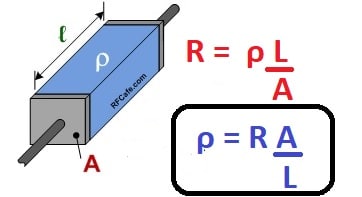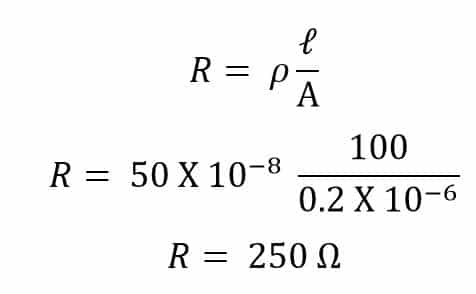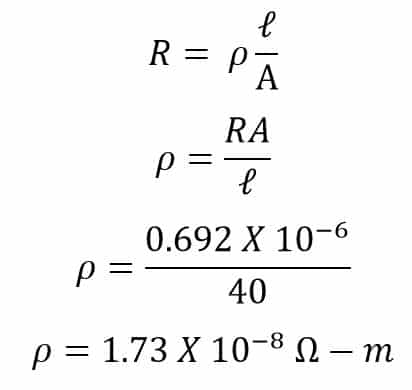What is Electrical Resistivity?
Electrical resistivity is the electrical resistance of a specific specimen of the material of unit length and unit cross-sectional area. The electrical resistivity shows the current opposing property of a conductor.
If the resistance of the material specimen of 1-meter length and 1 square meter cross-sectional area is 1 ohm. It means the resistivity of the material is 1 Ohm- meter.

The stronger the opposition, the higher the resistivity and the lower the current passing through it. Therefore, the resistivity of the material has paramount importance in electrical engineering.
It is easy to compare various materials usages on the basis of materials resistivity.
The resistivity of various materials is as given in the below table.
| Material | Resistivity (Ω-m) at 20°C |
| Silver | 1.59×10−8 |
| Copper | 1.68×10−8 |
| Gold | 2.44×10−8 |
| Aluminum | 2.82×10−8 |
| Tungsten | 5.60×10−8 |
| Zinc | 5.90×10−8 |
| Nickle | 6.99×10−8 |
Silver has the least resistivity among all the metals. Copper has less resistivity as compared to aluminum. Therefore, copper is the best conductor for electricity.
The resistivity of insulators is in the range of 1012 to 1020 ohm-meters. Therefore, the insulators have excellent current blocking property,
The resistivity of the conducting materials increases with an increase in temperature. The electrons collide and hinder the path of electrical current at higher temperatures. As a result, the resistivity of the conductor increase with an increase in temperature.
Contrary to this, the resistivity of the insulators & semiconductors decreases with an increase in temperature. As a result, these materials start easily passing the electric current through them. If the temperature increase is beyond the maximum permissible temperature limit, the insulator fails.
Similarly, the resistivity of the semiconductors decreases with an increase in temperature. Therefore, the insulators and semiconductors function reliably if the temperature remains well below the maximum permissible temperature range,
Symbol of Resistivity
The symbol of electrical resistivity, symbolized with a Greek Letter ρ(rho), is numerically equal to the resistance R of the sample piece of the material such as busbar, multiplied by its cross-sectional area A, and divided by its length L; (ρ=RA/L).
Electrical Resistivity Formula/ Equation
The resistance of the conductor depends on the following parameters.
- Resistivity of the material
- Cross-sectional area
- Length
Derivation of electrical resistivity equation/ Formula
R ∝ ρ ——-(1) R ∝ L ——-(2) R ∝ 1/ A ——-(3)
Thus,
R = ρ L/ A ——-(4)
ρ = RA/L ——-(5)
Here, R is resistance in Ohm(Ω)
A = Cross-sectional area in cm2 or m2
L = Length of conductor in centimeters(cm) or meters(m)
ρ = Resistivity of the material(Ω-cm) or (Ω-m)
Unit of Resistivity
The electrical resistivity of the material is directly proportional to the cross-sectional area and inversely proportional to the length.
ρ ∝ RA, Also ρ ∝ L
Therefore,
ρ ∝ R (A/L)
From above the unit of resistivity is
ρ ∝ R(A/L)
ρ ∝ Ohm(Cm2/Cm) ∝ Ohm-Centimeters
The unit of resistance is Ohm. In the mks ( meter-kilogram-second) system, the ratio of area and length is simplified to just meters. Thus, in the MKS system, the unit of resistivity is ohm-meter. If the length & cross-sectional area is in the centimeter & square of centimeters respectively, then the unit of resistivity is ohm-centimeter.
The reciprocal of the resistivity is the conductivity. The electrical conductivity shows the ability of the material to pass the electric current through it.
Solved problems on Electrical Resistivity
Problem 1:
Calculate the resistivity of the given material whose resistance, cross sectional area and length are 4 Ω , 50cm2 and 30 cm respectively?
Data given,
R = 4 Ω
l = 30 cm = 0.3 m
A = 50 cm2 = 0.25 m2
Resistivity formula is
ρ = RA/L
=( 4 x 0.25)/0.3
= 3.33 Ωm
Problem 2:
The conducting wire has length, area & resistance 0.4 m, 1.5 m2 & 2 Ω respectively. Calculate the resistivity?
Given
R = 2 Ω
l = 0.4 m and
A = 1.5 m2
Resistivity formula is
ρ = RA/L
=( 2 x 1.5)/0.4
= 7.5 Ωm
Problem 3:
Calculate the resistance of 100 m length of a wire having a uniform cross-sectional area of 0.2 mm2, if the wire is made of manganin having a resistivity of 50 × 10−8 Ω-m.
ℓ = 100 meter
A = 0.2 mm2 = 0.2 X 10-6 m2
ρ = 50 × 10 -8 Ω-m.

Problem 4
The resistance of a conductor 1 mm2 in cross-section and 40 m long is 0.692 Ω. Determine the specific resistance of the conducting material.
ℓ = 10 meter
A = 1 mm2 = 1 X 10-6 m
R = 0.692 Ω
ρ = ?

Read Next: